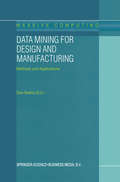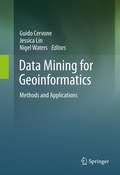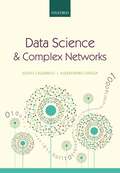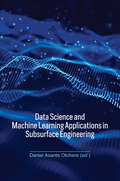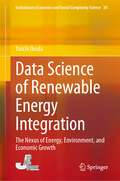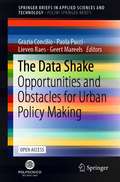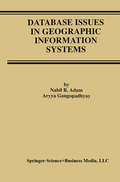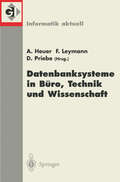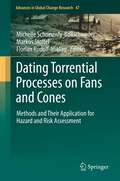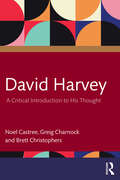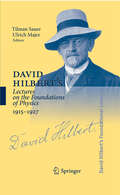- Table View
- List View
Data-Driven Numerical Modelling in Geodynamics: Methods and Applications (SpringerBriefs in Earth Sciences)
by Alik Ismail-Zadeh Alexander Korotkii Igor TsepelevThis book describes the methods and numerical approaches for data assimilation in geodynamical models and presents several applications of the described methodology in relevant case studies. The book starts with a brief overview of the basic principles in data-driven geodynamic modelling, inverse problems, and data assimilation methods, which is then followed by methodological chapters on backward advection, variational (or adjoint), and quasi-reversibility methods. The chapters are accompanied by case studies presenting the applicability of the methods for solving geodynamic problems; namely, mantle plume evolution; lithosphere dynamics in and beneath two distinct geological domains – the south-eastern Carpathian Mountains and the Japanese Islands; salt diapirism in sedimentary basins; and volcanic lava flow. Applications of data-driven modelling are of interest to the industry and to experts dealing with geohazards and risk mitigation. Explanation of the sedimentary basin evolution complicated by deformations due to salt tectonics can help in oil and gas exploration; better understanding of the stress-strain evolution in the past and stress localization in the present can provide an insight into large earthquake preparation processes; volcanic lava flow assessments can advise on risk mitigation in the populated areas. The book is an essential tool for advanced courses on data assimilation and numerical modelling in geodynamics.
Data Mining for Design and Manufacturing: Methods and Applications (Massive Computing #3)
by D. BrahaData Mining for Design and Manufacturing: Methods and Applications is the first book that brings together research and applications for data mining within design and manufacturing. The aim of the book is 1) to clarify the integration of data mining in engineering design and manufacturing, 2) to present a wide range of domains to which data mining can be applied, 3) to demonstrate the essential need for symbiotic collaboration of expertise in design and manufacturing, data mining, and information technology, and 4) to illustrate how to overcome central problems in design and manufacturing environments. The book also presents formal tools required to extract valuable information from design and manufacturing data, and facilitates interdisciplinary problem solving for enhanced decision making. Audience: The book is aimed at both academic and practising audiences. It can serve as a reference or textbook for senior or graduate level students in Engineering, Computer, and Management Sciences who are interested in data mining technologies. The book will be useful for practitioners interested in utilizing data mining techniques in design and manufacturing as well as for computer software developers engaged in developing data mining tools.
Data Mining for Geoinformatics: Methods and Applications
by Guido Cervone Jessica Lin Nigel WatersThe rate at which geospatial data is being generated exceeds our computational capabilities to extract patterns for the understanding of a dynamically changing world. Geoinformatics and data mining focuses on the development and implementation of computational algorithms to solve these problems. This unique volume contains a collection of chapters on state-of-the-art data mining techniques applied to geoinformatic problems of high complexity and important societal value. Data Mining for Geoinformatics addresses current concerns and developments relating to spatio-temporal data mining issues in remotely-sensed data, problems in meteorological data such as tornado formation, estimation of radiation from the Fukushima nuclear power plant, simulations of traffic data using OpenStreetMap, real time traffic applications of data stream mining, visual analytics of traffic and weather data and the exploratory visualization of collective, mobile objects such as the flocking behavior of wild chickens. This book is designed for researchers and advanced-level students focused on computer science, earth science and geography as a reference or secondary text book. Practitioners working in the areas of data mining and geoscience will also find this book to be a valuable reference.
Data, Models and Analysis: The Highest Impact Articles in 'Atmosphere-Ocean'
by Guoqi Han, Hai Lin and Douw SteynThis volume contains the ten most cited articles that have appeared in the journal Atmosphere-Ocean since 1995. These articles cover a wide range of topics in meteorology, climatology and oceanography. Modelling work is represented in five papers, covering global climate model development; a cumulus parameterization scheme for global climate models; development of a regional forecast modelling system and parameterization of peatland hydraulic processes for climate models. Data rehabilitation and compilation in order to support trend analysis work on comprehensive precipitation and temperature data sets is presented in four papers. Field studies are represented by a paper on the circumpolar lead system. While the modelling studies are global in their application and applicability, the data analysis and field study papers cover environments that are specifically, but not uniquely, Canadian. This book will be of interest to researchers, students and professionals in the various sub-fields of meteorology, oceanography and climate science.
Data, Models and Analysis: The Highest Impact Articles in 'Atmosphere-Ocean'
by Guoqi Han Hai Lin Douw SteynThis volume contains the ten most cited articles that have appeared in the journal Atmosphere-Ocean since 1995. These articles cover a wide range of topics in meteorology, climatology and oceanography. Modelling work is represented in five papers, covering global climate model development; a cumulus parameterization scheme for global climate models; development of a regional forecast modelling system and parameterization of peatland hydraulic processes for climate models. Data rehabilitation and compilation in order to support trend analysis work on comprehensive precipitation and temperature data sets is presented in four papers. Field studies are represented by a paper on the circumpolar lead system. While the modelling studies are global in their application and applicability, the data analysis and field study papers cover environments that are specifically, but not uniquely, Canadian. This book will be of interest to researchers, students and professionals in the various sub-fields of meteorology, oceanography and climate science.
Data Processing in Precise Time and Frequency Applications (Data and Knowledge in a Changing World)
by M. DesaintfuscienPhysical processes, involving atomic phenomena, allow more and more precise time and frequency measurements. This progress is not possible without convenient processing of the respective raw data. This book describes the data processing at various levels: design of the time and frequency references, characterization of the time and frequency references, and applications involving precise time and/or frequency references.
Data Science and Complex Networks: Real Case Studies with Python
by Guido Caldarelli Alessandro ChessaThis book provides a comprehensive yet short description of the basic concepts of Complex Network theory. In contrast to other books the authors present these concepts through real case studies. The application topics span from Foodwebs, to the Internet, the World Wide Web and the Social Networks, passing through the International Trade Web and Financial time series. The final part is devoted to definition and implementation of the most important network models. The text provides information on the structure of the data and on the quality of available datasets. Furthermore it provides a series of codes to allow immediate implementation of what is theoretically described in the book. Readers already used to the concepts introduced in this book can learn the art of coding in Python by using the online material. To this purpose the authors have set up a dedicated web site where readers can download and test the codes. The whole project is aimed as a learning tool for scientists and practitioners, enabling them to begin working instantly in the field of Complex Networks.
Data Science and Machine Learning Applications in Subsurface Engineering
by Daniel Asante OtchereThis book covers unsupervised learning, supervised learning, clustering approaches, feature engineering, explainable AI and multioutput regression models for subsurface engineering problems. Processing voluminous and complex data sets are the primary focus of the field of machine learning (ML). ML aims to develop data-driven methods and computational algorithms that can learn to identify complex and non-linear patterns to understand and predict the relationships between variables by analysing extensive data. Although ML models provide the final output for predictions, several steps need to be performed to achieve accurate predictions. These steps, data pre-processing, feature selection, feature engineering and outlier removal, are all contained in this book. New models are also developed using existing ML architecture and learning theories to improve the performance of traditional ML models and handle small and big data without manual adjustments. This research-oriented book will help subsurface engineers, geophysicists, and geoscientists become familiar with data science and ML advances relevant to subsurface engineering. Additionally, it demonstrates the use of data-driven approaches for salt identification, seismic interpretation, estimating enhanced oil recovery factor, predicting pore fluid types, petrophysical property prediction, estimating pressure drop in pipelines, bubble point pressure prediction, enhancing drilling mud loss, smart well completion and synthetic well log predictions.
Data Science and Machine Learning Applications in Subsurface Engineering
This book covers unsupervised learning, supervised learning, clustering approaches, feature engineering, explainable AI and multioutput regression models for subsurface engineering problems. Processing voluminous and complex data sets are the primary focus of the field of machine learning (ML). ML aims to develop data-driven methods and computational algorithms that can learn to identify complex and non-linear patterns to understand and predict the relationships between variables by analysing extensive data. Although ML models provide the final output for predictions, several steps need to be performed to achieve accurate predictions. These steps, data pre-processing, feature selection, feature engineering and outlier removal, are all contained in this book. New models are also developed using existing ML architecture and learning theories to improve the performance of traditional ML models and handle small and big data without manual adjustments. This research-oriented book will help subsurface engineers, geophysicists, and geoscientists become familiar with data science and ML advances relevant to subsurface engineering. Additionally, it demonstrates the use of data-driven approaches for salt identification, seismic interpretation, estimating enhanced oil recovery factor, predicting pore fluid types, petrophysical property prediction, estimating pressure drop in pipelines, bubble point pressure prediction, enhancing drilling mud loss, smart well completion and synthetic well log predictions.
Data Science of Renewable Energy Integration: The Nexus of Energy, Environment, and Economic Growth (Evolutionary Economics and Social Complexity Science #30)
by Yuichi IkedaThis book covers various data scientific approaches to analyze the issue of grid integration of renewable energy for which the grid flexibility is the key to cope with its intermittency. It provides readers with the scope to view renewable energy integration as establishing a distributed energy network instead of the traditional centralized energy system. Specifically, quantitative valuation system-wise of the levelized cost of energy, which includes both initial cost and various operational costs, enables readers to optimize energy systems in order to minimize economic cost and environmental impact. It is noted, however, that the high cost of integrating renewable energy on a large scale might slow economic growth considerably. Topics addressed in the book also include statistical comparative study of the relationship between energy and economic growth, a graphical model of determinant factors for foreign direct investment in renewable energy, the coupled oscillator model and unitcommitment model to capture intermittency of renewable energy, and the network model of evolving micro-grids. The book explains desired innovation to reduce the integration cost significantly using innovative technologies such as energy storage with hydrogen production and vehicle-to-grid technology. Illustrated by careful analysis of selected examples of renewable integration using different types of grid flexibility, this volume is indispensable to readers who make policy recommendations to establish the distributed energy network integrated with large-scale renewable energy by disentangling the nexus of energy, environment, and economic growth.
The Data Shake: Opportunities and Obstacles for Urban Policy Making (SpringerBriefs in Applied Sciences and Technology)
by Grazia Concilio Paola Pucci Lieven Raes Geert MareelsThis open access book represents one of the key milestones of PoliVisu, an H2020 research and innovation project funded by the European Commission under the call “Policy-development in the age of big data: data-driven policy-making, policy-modelling and policy-implementation”. It investigates the operative and organizational implications related to the use of the growing amount of available data on policy making processes, highlighting the experimental dimension of policy making that, thanks to data, proves to be more and more exploitable towards more effective and sustainable decisions. The first section of the book introduces the key questions highlighted by the PoliVisu project, which still represent operational and strategic challenges in the exploitation of data potentials in urban policy making. The second section explores how data and data visualisations can assume different roles in the different stages of a policy cycle and profoundly transform policy making.
Data Sharing for International Water Resource Management: Eastern Europe, Russia and the CIS (NATO Science Partnership Subseries: 2 #61)
by ThomasNaffThe Issues, Conclusions, and Recommendations of the NATO Advanced Research Workshop - Budapest, Hungary July 27 -31, 1997 TIlOMAS NAFF University of Pennsylvania 847 Williams Hall Philadelphia, PA 19104-6305 USA tna. /J"@sas. upenn. edu 1. The Issues Sharing data and infonnation enables people to think together in solving problems, in building trust essential for cooperative efforts toward sustaining shared vital natural resources, and in avoiding conflict. It is axiomatic that all planning and policy making, not least for environmental and resource sustainability, depend for success on accmate data and infonnation dispensed freely to all who need it, from farmers to heads of state. These maxims are particularly apt when applied to water resources that are international and transboundary. In those circumstances, the need for cooperation and sharing are acute if the water source is to be managed, distributed, and used equitably and efficiently. In many parts of the world, the collection, management, reporting, and quality of water and environmental data are often so poor and incomplete as to render them useless, or they are treated as security issues and are therefore classified. Either way, wherever those conditions exist, essential planning and policy data and information of good quality are relatively hard to come by. The consequences are high, particularly for effective basin-wide river management and resource sustainability.
Database Issues in Geographic Information Systems (Advances in Database Systems #6)
by Nabil R. Adam Aryya GangopadhyayGeographic Information Systems (GIS) have been experiencing a steady and unprecedented growth in terms of general interest, theory development, and new applications in the last decade or so. GIS is an inter-disciplinary field that brings together many diverse areas such as computer science, geography, cartography, engineering, and urban planning. Database Issues in Geographic Information Systems approaches several important topics in GIS from a database perspective. Database management has a central role to play in most computer-based information systems, and is expected to have an equally important role to play in managing information in GIS as well. Existing database technology, however, focuses on the alphanumeric data that are required in business applications. GIS, like many other application areas, requires the ability to handle spatial as well as alphanumeric data. This requires new innovations in data management, which is the central theme of this monograph. The monograph begins with an overview of different application areas and their data and functional requirements. Next it addresses the following topics in the context of GIS: representation and manipulation of spatial data, data modeling, indexing, and query processing. Future research directions are outlined in each of the above topics. The last chapter discusses issues that are emerging as important areas of technological innovations in GIS. Database Issues in Geographic Information Systems is suitable as a secondary text for a graduate level course on Geographic Information Systems, Database Systems or Cartography, and as a reference for researchers and practitioners in industry.
Datenbanksysteme in Büro, Technik und Wissenschaft: 9. GI-Fachtagung Oldenburg, 7.-9. März 2001 (Informatik aktuell)
by Andreas Heuer Frank Leymann Denny PriebeDating Torrential Processes on Fans and Cones: Methods and Their Application for Hazard and Risk Assessment (Advances in Global Change Research #47)
by Michelle Schneuwly-Bollschweiler, Markus Stoffel and Florian Rudolf-MiklauThis book provides a detailed overview on methods used for the dating of past torrential activity on fans and cones and fosters the discussion on the impact of past and potential future climate change on torrential processes. The book has a clear focus on the practical applications of these methods, complemented by case studies. The limits of each dating method in case of excessive natural and human interventions on fans and cones are shown.
The Daunting Climate Change: Science, Impacts, Adaptation & Mitigation Strategies, Policy Responses
by Jayarama Reddy PuthalpetThe book starts with an overview of Climate Science. It discusses the signs of Warming, the impacts and consequences on several sectors - terrestrial and coastal ecosystems, water resources, ocean systems, agriculture, food production and food security, human health and safety, livelihoods and poverty, Arctic populations, low-lying States, so on. Mathematical models to project future climate and the resulting concerns, global adaptation experiences, and opportunities for future execution are explained. The mitigation approaches, chiefly decarbonizing the energy sector by developing and applying clean/low carbon energy sources and improving energy efficiency, and the evolving geoengineering schemes are dealt. Carbon pricing, an economic tool to ensure emissions reductions, and transition to a low carbon economy to stimulate sustainable growth are described. The continued global efforts under the UN or otherwise until the recent Paris Agreement to arrive at policy responses to tackle this intriguing but daunting problem of climate change are vividly expounded. Note: T&F does not sell or distribute the hardback in India, Pakistan, Nepal, Bhutan, Bangladesh and Sri Lanka.
The Daunting Climate Change: Science, Impacts, Adaptation & Mitigation Strategies, Policy Responses
by Jayarama Reddy PuthalpetThe book starts with an overview of Climate Science. It discusses the signs of Warming, the impacts and consequences on several sectors - terrestrial and coastal ecosystems, water resources, ocean systems, agriculture, food production and food security, human health and safety, livelihoods and poverty, Arctic populations, low-lying States, so on. Mathematical models to project future climate and the resulting concerns, global adaptation experiences, and opportunities for future execution are explained. The mitigation approaches, chiefly decarbonizing the energy sector by developing and applying clean/low carbon energy sources and improving energy efficiency, and the evolving geoengineering schemes are dealt. Carbon pricing, an economic tool to ensure emissions reductions, and transition to a low carbon economy to stimulate sustainable growth are described. The continued global efforts under the UN or otherwise until the recent Paris Agreement to arrive at policy responses to tackle this intriguing but daunting problem of climate change are vividly expounded. Note: T&F does not sell or distribute the hardback in India, Pakistan, Nepal, Bhutan, Bangladesh and Sri Lanka.
The David Attenborough Activity Book: An Unofficial Lovefest
by null Nathan JoyceA highly diverting celebration of television’s favourite naturalist, packed with games, trivia and Attenborough-inspired activities. Attenborough. Just saying the name makes everyone feel better. Words like 'dependable', 'inspiring' and 'soothing' cascade like the rains returning to the sun-parched savanna. And according to a recent poll, he's the most trustworthy person alive, above Michelle Obama and The Queen. As the saga of Boaty, McBoatface showed (the research ship was finally called RRS Sir David Attenborough), British people love silliness. And this book is a celebration of our two favourite things: Attenborough and silliness. You'll find games like Guess the animal from David's description, the David Attenborough drinking game, Create your own Attenborough coat of arms, Spot the fake species, Attenbingo, come up with a new animal print design for David's patented blue shirt in Patternborough, and if you find yourself in times of trouble, seek solace with the What would Attenborough do? self-help guide. Everything you've ever wanted to know about the great man – from fun facts and remarkable quotes, plus ludicrous games – lies within the sustainably forested habitat of these pages. It's the perfect present for, well, anyone, really.
David Attenborough Lines to Live By: Embrace the wonder of your world
by Pop Press'I am hopeful for the future, because although nature is in crisis, now is the time for action.'For 70 years, David Attenborough's soothing voice has brought the magic of nature to our TV screens, teaching millions around the world about beautiful animals and the climate crisis that endangers them.David Attenborough Lines to Live By is a celebration of Sir David's impact on the natural world and will inspire everyone to appreciate and protect the fragile world around us.
David Harvey: A Critical Introduction to His Thought
by Noel Castree Greig Charnock Brett ChristophersDavid Harvey is among the most influential Marxist thinkers of the last half century. This book offers a lucid and authoritative introduction to his work, with a structure designed to reflect the enduring topics and insights that serve to unify Harvey’s writings over a long period of time. Harvey’s writings have exerted huge influence within the social sciences and the humanities. In addition, his work now commands a global readership among Left political activists and those interested in current world affairs. Harvey’s central preoccupation is capitalism and the impacts of its growth-obsessed, contradictory dynamics. His name is synonymous with key analytical concepts like ‘the spatial fix’ and ‘accumulation by dispossession’. This critical introduction to his thought is an essential companion for both new and more experienced readers. The critique of capitalism is one of the most important undertakings of our time, and Harvey’s work offers powerful tools to help us see why a ‘softer’ capitalism is insufficient and a post-capitalist future is necessary. This book is an important resource for scholars and graduate students in geography, politics and many other disciplines across the social sciences and humanities.
David Harvey: A Critical Introduction to His Thought
by Noel Castree Greig Charnock Brett ChristophersDavid Harvey is among the most influential Marxist thinkers of the last half century. This book offers a lucid and authoritative introduction to his work, with a structure designed to reflect the enduring topics and insights that serve to unify Harvey’s writings over a long period of time. Harvey’s writings have exerted huge influence within the social sciences and the humanities. In addition, his work now commands a global readership among Left political activists and those interested in current world affairs. Harvey’s central preoccupation is capitalism and the impacts of its growth-obsessed, contradictory dynamics. His name is synonymous with key analytical concepts like ‘the spatial fix’ and ‘accumulation by dispossession’. This critical introduction to his thought is an essential companion for both new and more experienced readers. The critique of capitalism is one of the most important undertakings of our time, and Harvey’s work offers powerful tools to help us see why a ‘softer’ capitalism is insufficient and a post-capitalist future is necessary. This book is an important resource for scholars and graduate students in geography, politics and many other disciplines across the social sciences and humanities.
David Harvey's Geography: Social And Cultural Geography: David Harvey's Geography (Routledge Library Editions: Social and Cultural Geography)
by John L. PatersonThe emphasis of this book is to explore two major philosophical influences in contemporary human geography, namely logical positivism and Marxism, and to explore the relationships between philosophy, methodology and geographical research. Rather than being a biography of David Harvey, the book contributes to the understanding of one of the most innovative and iconoclastic scholars in contemporary Anglo-American human geography.
David Harvey's Geography (Routledge Library Editions: Social and Cultural Geography)
by John L. PatersonThe emphasis of this book is to explore two major philosophical influences in contemporary human geography, namely logical positivism and Marxism, and to explore the relationships between philosophy, methodology and geographical research. Rather than being a biography of David Harvey, the book contributes to the understanding of one of the most innovative and iconoclastic scholars in contemporary Anglo-American human geography.
David Hilbert and the Axiomatization of Physics: From Grundlagen der Geometrie to Grundlagen der Physik (Archimedes #10)
by L. CorryDavid Hilbert (1862-1943) was the most influential mathematician of the early twentieth century and, together with Henri Poincaré, the last mathematical universalist. His main known areas of research and influence were in pure mathematics (algebra, number theory, geometry, integral equations and analysis, logic and foundations), but he was also known to have some interest in physical topics. The latter, however, was traditionally conceived as comprising only sporadic incursions into a scientific domain which was essentially foreign to his mainstream of activity and in which he only made scattered, if important, contributions. Based on an extensive use of mainly unpublished archival sources, the present book presents a totally fresh and comprehensive picture of Hilbert’s intense, original, well-informed, and highly influential involvement with physics, that spanned his entire career and that constituted a truly main focus of interest in his scientific horizon. His program for axiomatizing physical theories provides the connecting link with his research in more purely mathematical fields, especially geometry, and a unifying point of view from which to understand his physical activities in general. In particular, the now famous dialogue and interaction between Hilbert and Einstein, leading to the formulation in 1915 of the generally covariant field-equations of gravitation, is adequately explored here within the natural context of Hilbert’s overall scientific world-view. This book will be of interest to historians of physics and of mathematics, to historically-minded physicists and mathematicians, and to philosophers of science.
David Hilbert's Lectures on the Foundations of Physics 1915-1927: Relativity, Quantum Theory and Epistemology
by Arne Schirrmacher Heinz-Jürgen SchmidtThese documents do nothing less than bear witness to one of the most dramatic changes in the foundations of science. The book has three sections that cover general relativity, epistemological issues, and quantum mechanics. This fascinating work will be a vital text for historians and philosophers of physics, as well as researchers in related physical theories.

